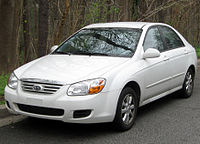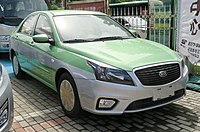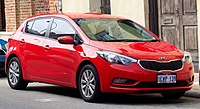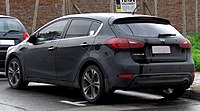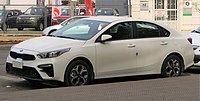Kia Cerato
| Kia Cerato | |
|---|---|
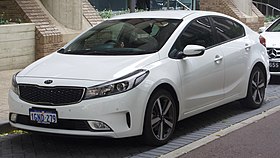 | |
| Overview | |
| Manufacturer | Kia |
| Also called | Kia Forte/K3 (2009–present) |
| Production | 2003–present |
| Body and chassis | |
| Class | Compact car (C-segment) |
| Body style | 5-door hatchback 4-door sedan/saloon |
| Layout | Front-engine, front-wheel-drive |
| Chronology | |
| Predecessor | Kia Sephia |
| Successor | Kia K4 |
The Kia Cerato (also known as the Kia Forte in North America, K3 in South Korea or the Forte K3 or Shuma in China) is a compact car produced by the South Korean manufacturer Kia since 2003. In 2008, the Cerato nameplate was replaced by the Forte nameplate in the North American market and the K3 nameplate in South Korea. However, the "Cerato" name remains in use in markets such as Australasia, Middle East and Latin America. It is available in five-door hatchback, two-door coupe and four-door sedan variants. It is not available in Europe, where the similar sized Kia Ceed is offered (except for Russia and Ukraine, where the Ceed and the Cerato are both available).
In some markets, such as North America, the Cerato is marketed as the Kia Forte replacing the Spectra nameplate of previous generations. In Colombia and Singapore, the name Cerato Forte was used for the second generation,[1] while Naza Automotive Manufacturing of Malaysia has assembled the vehicle since 2009, selling it there under the name Naza Forte.[2]
First generation (LD; 2003)[edit]
| First generation (LD) | |
|---|---|
 Kia Cerato sedan (China) | |
| Overview | |
| Also called |
|
| Production | 2003–2008 2004–2020 (China)[3] |
| Model years | 2004–2009 |
| Assembly | South Korea: Hwaseong (Hwaseong Plant) China: Yancheng (Yancheng Plant) (DYK) Malaysia: Gurun (NAM) |
| Body and chassis | |
| Body style | 4-door sedan 5-door hatchback |
| Platform | Hyundai-Kia J3 platform |
| Related | Kia Carens |
| Powertrain | |
| Engine | |
| Transmission | 5-speed manual 4-speed automatic |
| Dimensions | |
| Wheelbase | 2,610 mm (102.8 in) |
| Length | 2003–06 sedan: 4,480 mm (176.4 in) 2006–08 sedans: 4,500 mm (177.2 in) 2003–06 hatchback: 4,341 mm (170.9 in) 2006–09 hatchback: 4,350 mm (171.3 in) |
| Width | 1,735 mm (68.3 in) |
| Height | 1,470 mm (57.9 in) |
| Chronology | |
| Successor | Kia Ceed (hatchback) |
The Kia Cerato was introduced in South Korea in 2003, sharing a platform with the Hyundai Elantra (XD) and using Hyundai's Beta II (G4GC) (CVVT-enabled) four-cylinder engine. It replaced the Sephia/Mentor sedan and Shuma hatchback.
In North America, the "Spectra" name was used when introduced for the 2004 model year, with "Spectra5" designating the hatchback. For Latin American markets, the Cerato was still named Sephia until 2005, when it was discontinued in favor of the name Spectra. In Europe, the Cerato was replaced by the Kia Cee'd.
For the Malaysian market, the first generation Spectra was launched in Malaysia on August 15, 2007 as the "Spectra5" available only with one trim level and with the hatchback bodystyle powered by a 1.6-litre, four-cylinder, 16-valve, DOHC CVVT engine with a 4-speed automatic transmission.[4]
-
2005 Kia Cerato SE sedan (UK)
-
2004–2006 Kia Spectra5 hatchback (US)
-
2004–2006 Kia Spectra5 SX hatchback (US)
Facelift[edit]
In 2006, a facelift version was introduced, including revised Gamma engines. Stylistically, the bumper and headlamps lost their pronounced crease near the grille area, the trunk lid became more rounded, and the tail lights were reshaped.
-
2007-09 Kia Spectra EX sedan (US)
-
2007-09 Kia Spectra EX sedan (US)
-
2008 Kia Cerato sedan (China)
-
2008 Kia Cerato hatchback (Europe)
-
2008 Kia Cerato hatchback (Europe)
-
2007 Kia Spectra5 hatchback (US)
Kia Cerato R and Horki 300EV[edit]
The Kia Cerato R is the extensive facelift of the Kia Cerato to extend sales within the Chinese market, while the second generation Kia Cerato was sold as the Kia Forte in China at the same time. The design was significantly updated to be in line with other newer Kia products. The Horki 300EV is an compact electric sedan with the design being essentially a rebadged version of the Kia Cerato R from the Chinese market, it was unveiled on the 2016 Auto Guangzhou. The platform is the same as the first generation Kia Cerato, which is still in production in China as the Cerato R.[5][6]
-
Kia Cerato R taxi (CN)
-
Kia Cerato R taxi (CN)
-
Horki 300E (CN)
Second generation (TD; 2008)[edit]
The second generation Kia Cerato was launched in South Korea in late 2008 under the Kia Forte name – a name that was used in most international markets. The "Cerato" name has been retained in some markets, such as Australia, Middle East, South Africa and Brazil. In Singapore, the second generation model is badged "Kia Cerato Forte".[7]
Hatchback[edit]
-
2012 Kia Cerato SX
-
Kia Cerato TD hatchback (Australia)
Sedan[edit]
-
Kia Cerato Sedan (Europe)
-
Kia Cerato Sedan (Europe)
Coupe (Koup)[edit]
-
2011 Kia Cerato "Koup" (Chile)
-
Kia Cerato "Koup" rear
Third generation (YD; 2012)[edit]
Kia released images of the third generation Cerato for the 2014 model year in late July 2012, when the company revealed its Korean-market counterpart, Kia K3.[8] The car is completely redesigned with a lower, wider, and longer stance.
Hatchback[edit]
-
2014 Kia Cerato (Australia)
-
Kia Cerato Si hatchback
-
2014 Kia Cerato SX with upgraded trim and lights
Sedan[edit]
-
2015 Kia Cerato SX sedan (Malaysia)
-
Kia Cerato S
-
2015 Kia Cerato SLi sedan with upgraded trim and lights
Coupe[edit]
-
Kia Cerato Koup SX
-
Kia Cerato Koup SX (rear)
Fourth generation (BD; 2018)[edit]
The fourth generation Cerato was unveiled as the Forte on January 15, 2018 at the 2018 North American International Auto Show in Detroit, Michigan. Entering its third generation, a more sophisticated design and desirable features transform one of Kia's best-selling vehicles into something more than a compact car for taking people going from one point to another. Thanks to a number of improvements, Cerato now offers greater driver comfort, fuel economy and advanced driver assistance technologies.
-
Kia Cerato EX sedan
-
Kia Cerato EX hatchback
-
Kia Cerato EX sedan
Sales[edit]
| Calendar year | Vietnam[9] |
|---|---|
| 2016 | 2,696[10] |
| 2017 | 5,651[11] |
| 2018 | 11,710[12] |
| 2019 | 11,313[13] |
| 2020 | 12,033[14] |
References[edit]
- ^ "Kia launches the new Cerato Forte for the Singaporean market". iCars Singapore. 31 January 2009. Archived from the original on 6 October 2011. Retrieved 9 October 2010.
- ^ Yaohan, Seow (26 November 2009). "Naza Kia Launches The Forte In Malaysia". News.motorstop.asia. Archived from the original on 11 October 2010. Retrieved 9 October 2010.
- ^ "Cerato". DYK. Archived from the original on 2020-08-02. Retrieved 2017-04-14.
- ^ "Naza Kia Launches All-New Kia Optima and new-look Spectra". Autoworld.com.my. 2007-08-22. Retrieved 2018-05-06.
- ^ "The Dongfeng-Yueda-Kia Horki 300EV Is Finally Ready For China".
- ^ "Spy Shots: Horki 300E EV Sedan Is Ready For China".
- ^ "Kia launches the new Cerato Forte". iCars Singapore. 2009-01-31. Archived from the original on 2011-10-06. Retrieved 2010-10-30.
- ^ "2014 Kia Forte Unveiled, Heading to America Early Next Year". AutoGuide.com. 29 July 2012. Retrieved 8 September 2012.
- ^ "Report on car sales in Vietnam". xeoto.com.vn. Archived from the original on 2021-01-16. Retrieved 2021-01-16.
- ^ "Vietnam cars sales report 2016". Xeoto.com.vn. Vietnam. Archived from the original on 10 January 2021. Retrieved 25 December 2020.
- ^ "Vietnam cars sales report 2017". Xeoto.com.vn. Vietnam. Archived from the original on 9 January 2021. Retrieved 25 December 2020.
- ^ "Vietnam cars sales report 2018". Xeoto.com.vn. Vietnam. Archived from the original on 11 January 2021. Retrieved 25 December 2020.
- ^ "10 cars Vietnam sales report 2019". Xeoto.com.vn. Vietnam. Archived from the original on 8 January 2021. Retrieved 25 December 2020.
- ^ "10 cars Vietnam sales report 2020". Xeoto.com.vn. Vietnam. Archived from the original on 14 April 2021. Retrieved 25 December 2020.




